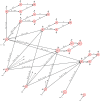Analysis of multi-strain infection of vaccinated and recovered population through epidemic model: Application to COVID-19
- PMID: 35905113
- PMCID: PMC9337708
- DOI: 10.1371/journal.pone.0271446
Analysis of multi-strain infection of vaccinated and recovered population through epidemic model: Application to COVID-19
Abstract
In this work, an innovative multi-strain SV EAIR epidemic model is developed for the study of the spread of a multi-strain infectious disease in a population infected by mutations of the disease. The population is assumed to be completely susceptible to n different variants of the disease, and those who are vaccinated and recovered from a specific strain k (k ≤ n) are immune to previous and present strains j = 1, 2, ⋯, k, but can still be infected by newer emerging strains j = k + 1, k + 2, ⋯, n. The model is designed to simulate the emergence and dissemination of viral strains. All the equilibrium points of the system are calculated and the conditions for existence and global stability of these points are investigated and used to answer the question as to whether it is possible for the population to have an endemic with more than one strain. An interesting result that shows that a strain with a reproduction number greater than one can still die out on the long run if a newer emerging strain has a greater reproduction number is verified numerically. The effect of vaccines on the population is also analyzed and a bound for the herd immunity threshold is calculated. The validity of the work done is verified through numerical simulations by applying the proposed model and strategy to analyze the multi-strains of the COVID-19 virus, in particular, the Delta and the Omicron variants, in the United State.
Conflict of interest statement
The authors have declared that no competing interests exist.
Figures














Similar articles
-
Vaccine breakthrough and rebound infections modeling: Analysis for the United States and the ten U.S. HHS regions.Infect Dis Model. 2023 Sep;8(3):717-741. doi: 10.1016/j.idm.2023.05.010. Epub 2023 Jun 2. Infect Dis Model. 2023. PMID: 37361410 Free PMC article.
-
The local stability of a modified multi-strain SIR model for emerging viral strains.PLoS One. 2020 Dec 9;15(12):e0243408. doi: 10.1371/journal.pone.0243408. eCollection 2020. PLoS One. 2020. PMID: 33296417 Free PMC article.
-
On a two-strain epidemic mathematical model with vaccination.Comput Methods Biomech Biomed Engin. 2024 Apr;27(5):632-650. doi: 10.1080/10255842.2023.2197542. Epub 2023 Apr 5. Comput Methods Biomech Biomed Engin. 2024. PMID: 37018044
-
Modeling the dynamics of COVID-19 in the presence of Delta and Omicron variants with vaccination and non-pharmaceutical interventions.Heliyon. 2023 Jul 5;9(7):e17900. doi: 10.1016/j.heliyon.2023.e17900. eCollection 2023 Jul. Heliyon. 2023. PMID: 37539217 Free PMC article.
-
The Global Epidemic of the SARS-CoV-2 Delta Variant, Key Spike Mutations and Immune Escape.Front Immunol. 2021 Nov 30;12:751778. doi: 10.3389/fimmu.2021.751778. eCollection 2021. Front Immunol. 2021. PMID: 34917076 Free PMC article. Review.
Cited by
-
Effect of Transmission and Vaccination on Time to Dominance of Emerging Viral Strains: A Simulation-Based Study.Microorganisms. 2023 Mar 28;11(4):860. doi: 10.3390/microorganisms11040860. Microorganisms. 2023. PMID: 37110282 Free PMC article.
-
Vaccine breakthrough and rebound infections modeling: Analysis for the United States and the ten U.S. HHS regions.Infect Dis Model. 2023 Sep;8(3):717-741. doi: 10.1016/j.idm.2023.05.010. Epub 2023 Jun 2. Infect Dis Model. 2023. PMID: 37361410 Free PMC article.
-
Sic Transit Gloria Mundi: A Mathematical Theory of Popularity Waves Based on a SIIRR Model of Epidemic Spread.Entropy (Basel). 2025 Jun 9;27(6):611. doi: 10.3390/e27060611. Entropy (Basel). 2025. PMID: 40566198 Free PMC article.
References
-
- US government SARS-COV-2 Interagency Group (SIG). https://cdc.gov/coronavirus/2019-ncov/variants/variant-info.html.
-
- The United States Center for Disease and Control: Information on OMICRON variant. https://cdc.gov/coronavirus/2019-ncov/variants/omicron-variant.html
-
- The United States Center for Disease and Control: Information on DELTA variant. https://cdc.gov/coronavirus/2019-ncov/variants/delta-variant.html
MeSH terms
Supplementary concepts
LinkOut - more resources
Full Text Sources
Medical

